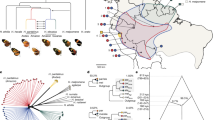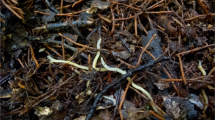Abstract
Sexual reproduction in non-vascular plants requires unicellular free-motile sperm to travel from male to female reproductive structures across the terrestrial landscape1. Recent data suggest that microarthropods can disperse sperm in mosses2. However, little is known about the chemical communication, if any, that is involved in this interaction or the relative importance of microarthropod dispersal compared to abiotic dispersal agents in mosses. Here we show that tissues of the cosmopolitan moss Ceratodon purpureus emit complex volatile scents, similar in chemical diversity to those described in pollination mutualisms between flowering plants and insects, that the chemical composition of C. purpureus volatiles are sex-specific, and that moss-dwelling microarthropods are differentially attracted to these sex-specific moss volatile cues. Furthermore, using experimental microcosms, we show that microarthropods significantly increase moss fertilization rates, even in the presence of water spray, highlighting the important role of microarthropod dispersal in contributing to moss mating success. Taken together, our results indicate the presence of a scent-based ‘plant–pollinator-like’ relationship that has evolved between two of Earth’s most ancient terrestrial lineages, mosses and microarthropods.
This is a preview of subscription content, access via your institution
Access options
Subscribe to this journal
Receive 51 print issues and online access
$199.00 per year
only $3.90 per issue
Buy this article
- Purchase on Springer Link
- Instant access to full article PDF
Prices may be subject to local taxes which are calculated during checkout




Similar content being viewed by others
References
Paolillo, D. J. J. The swimming sperms of land plants. Bioscience 31, 367–373 (1981)
Cronberg, N., Natcheva, R. & Hedlund, K. Microarthropods mediate sperm transfer in mosses. Science 313, 1255 (2006)
Nickrent, D. L., Parkinson, C. L., Palmer, J. D. & Duff, R. J. Multigene phylogeny of land plants with special reference to bryophytes and the earliest land plants. Mol. Biol. Evol. 17, 1885–1895 (2000)
Kenrick, P. & Crane, P. R. The origin and early evolution of land plants. Nature 389, 33–39 (1997)
Muggoch, H. & Walton, J. On the dehiscence of the antheridium and the part played by surface tension in the dispersal of spermatocytes in Bryophyta. Proc. R.. Soc. Lond. B 130, 448–461 (1942)
Longton, R. E. Reproductive biology and evolutionary potential in bryophytes. J. Hattori Bot. Lab. 41, 205–223 (1976)
Shaw, A. J. in Bryophyte Biology (eds Shaw, A. J. & Goffinet, B. ) 369–402 (Cambridge Univ. Press, 2000)
Andrew, N. R., Rodgerson, L. & Dunlop, M. Variation in invertebrate-bryophyte community structure at different spatial scales along altitudinal gradients. J. Biogeogr. 30, 731–746 (2003)
Rosenstiel, T. N. & Eppley, S. M. Long-lived sperm in the geothermal bryophyte Pohlia nutans. Biol. Lett. 5, 857–860 (2009)
Shortlidge, E. E., Rosenstiel, T. N. & Eppley, S. M. Tolerance to environmental desiccation in moss sperm. New Phytol. 194, 741–750 (2012)
Verhoef, H. A., Nagelkerke, C. J. & Joosse, E. N. G. Aggregation pheromones in Collembola. J. Insect Physiol. 23, 1009–1013 (1977)
Raspotnig, G., Krisper, G., Schuster, R., Fauler, G. & Leis, H. J. Volatile exudates from the oribatid mite, Platynothrus peltifer. J. Chem. Ecol. 31, 419–430 (2005)
Bengtsson, G., Erlandsson, A. & Rundgren, S. Fungal odour attracts soil Collembola. Soil Biol. Biochem. 20, 25–30 (1988)
Knudsen, J. T., Tollsten, L. & Bergstrom, L. G. Floral scents — a checklist of volatile compounds isolated by headspace techniques. Phytochemistry 33, 253–280 (1993)
Crepet, W. L. Advanced (constant) insect pollination mechanisms: pattern of evolution and implications vis-a-vis angiosperm diversity. Ann. Mo. Bot. Gard. 71, 607–630 (1984)
Schiestl, F. P. The evolution of floral scent and insect chemical communication. Ecol. Lett. 13, 643–656 (2010)
Raguso, R. A. Wake up and smell the roses: the ecology and evolution of floral scent. Annu. Rev. Ecol. Evol. Syst. 39, 549–569 (2008)
Ashman, T. L. Sniffing out patterns of sexual dimorphism in floral scent. Funct. Ecol. 23, 852–862 (2009)
Shaw, A. J. & Gaughan, J. F. Control of sex-ratios in haploid populations of the moss, Ceratodon purpureus. Am. J. Bot. 80, 584–591 (1993)
Stark, L. R., McLetchie, D. N. & Eppley, S. M. Sex ratios and the shy male hypothesis in Bryum argenteum (Bryaceae). Bryologist 113, 788–797 (2010)
Bisang, I. & Hedenäs, L. Sex ratio patterns in dioicous bryophytes re-visited. J. Bryol. 27, 207–219 (2005)
Hemborg, A. M. & Bond, W. J. Different rewards in female and male flowers can explain the evolution of sexual dimorphism in plants. Biol. J. Linn. Soc. 85, 97–109 (2005)
Varga, S. & Kytoviita, M. M. Sex-specific responses to mycorrhiza in a dioecious species. Am. J. Bot. 95, 1225–1232 (2008)
Voigt, C. C., Caspers, B. & Speck, S. Bats, bacteria, and bat smell: sex-specific diversity of microbes in a sexually selected scent organ. J. Mamm. 86, 745–749 (2005)
Pankow, J. F. et al. Volatilizable biogenic organic compounds (VBOCs) with two dimensional gas chromatography-time of flight mass spectrometry (GC×GC–TOFMS): sampling methods, VBOC complexity, and chromatographic retention data. Atmos. Meas. Tech. Discuss. 4, 3647–3684 (2011)
Thimm, T. & Larink, O. Grazing preferences of some collembola for endomycorrhizal fungi. Biol. Fertil. Soils 19, 266–268 (1995)
Sadaka-Laulan, N., Ponge, J. F., Roquebert, M. F., Bury, E. & Boumezzough, A. Feeding preferences of the Collembolan Onychiurus sinensis for fungi colonizing holm oak litter (Quercus rotundifolia Lam.). Eur. J. Soil Biol. 34, 179–188 (1998)
Staaden, S., Milcu, A., Rohlfs, M. & Scheu, S. Olfactory cues associated with fungal grazing intensity and secondary metabolite pathway modulate Collembola foraging behaviour. Soil Biol. Biochem. 43, 1411–1416 (2011)
Lawton, E. Moss Flora of the Pacific Northwest. (Hattori Botanical Laboratory, 1971)
Fountain, M. T. & Hopkin, S. P. Folsomia candida (Collembola): A “standard” soil arthropod. Annu. Rev. Entomol. 50, 201–222 (2005)
Johnson, D. L. & Wellington, W. G. Predation of Apochthonius minimus (Pseudoscorpionida: Chthoniidae) on Folsomia candida (Collembola: Isotomidae) I. Predation rate and size-selection. Res. Popul. Ecol. (Kyoto) 22, 339–352 (1980)
Xu, J., Ke, X., Krogh, P. H., Wang, Y., Lou, Y.-M. & Song, J. Evaluation of growth and reproduction as indicators of soil metal toxicity to the Collembolan, Sinella curvis. Insect Sci. 16, 57–63 (2009)
Steidle, J. L. M. & Schöller, M. Olfactory host location and learning in the granary weevil parasitoid Lariophagus distinguendus (Hymenoptera: Pteromalidae). J. Insect Behav. 10, 331–342 (1997)
Mishler, B. D. Reproductive biology and species distinctions in the moss genus Tortula, as represented in Mexico. Syst. Bot. 15, 86–97 (1990)
van Dam, N. M. & Poppy, G. M. Why plant volatile analysis needs bioinformatics-detecting signals from noise in increasingly complex profiles. Plant Biol. 10, 29–37 (2008)
SAS Institute. JMP for Windows. Release 10.0.0. (SAS Institute, 2012)
Acknowledgements
We are grateful to W. Luo and L. Isabelle for analytical assistance, to C. Rupert for assistance with the preference assays, and to L. Stark and N. McLetchie for plant material. Funding was provided by the 3M Corporation and the National Science Foundation (DEB-0743461 to S.M.E. and IOS-0719570 to T.N.R).
Author information
Authors and Affiliations
Contributions
S.M.E. and T.N.R. coordinated and planned the project. E.E.S., S.M.E., and T.N.R. initiated and carried out the experiments. A.N.M., J.F.P.. and T.N.R. were responsible for the gas chromatography data and analyses. All authors contributed to the writing of the manuscript.
Corresponding author
Ethics declarations
Competing interests
The authors declare no competing financial interests.
Supplementary information
Supplementary Data
This file contains Supplementary Table 1. (PDF 257 kb)
Rights and permissions
About this article
Cite this article
Rosenstiel, T., Shortlidge, E., Melnychenko, A. et al. Sex-specific volatile compounds influence microarthropod-mediated fertilization of moss. Nature 489, 431–433 (2012). https://doi.org/10.1038/nature11330
Received:
Accepted:
Published:
Issue Date:
DOI: https://doi.org/10.1038/nature11330
This article is cited by
-
Microbiome and related structural features of Earth’s most archaic plant indicate early plant symbiosis attributes
Scientific Reports (2022)
-
Bryophytes can recognize their neighbours through volatile organic compounds
Scientific Reports (2020)
-
Bacterial volatiles from mealybug honeydew exhibit kairomonal activity toward solitary endoparasitoid Anagyrus dactylopii
Journal of Pest Science (2020)
-
Chemical communication in springtails: a review of facts and perspectives
Biology and Fertility of Soils (2019)
-
Community-wide integration of floral colour and scent in a Mediterranean scrubland
Nature Ecology & Evolution (2017)
Comments
By submitting a comment you agree to abide by our Terms and Community Guidelines. If you find something abusive or that does not comply with our terms or guidelines please flag it as inappropriate.



